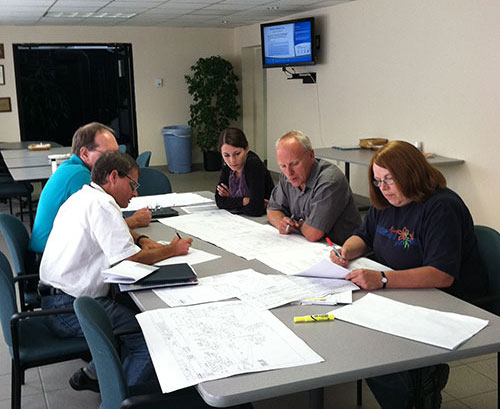
As an engineering service provider, one of the most impactful skills we employ for our clients is the ability to reduce the risks associated with their capital project investments. The road to a successful project implementation is fraught with many twists, turns, and obstacles when it comes to securing the benefits as intended when a company first sets out to make a plant or process improvement. Things like establishing your User Requirements and an affordable project scope can be diversions. Technology selection becomes another fork in the road. Selecting the “best fit” equipment providers is yet another obstacle to overcome. More twists and turns are experienced as the project plan is executed and day-to-day tactical decisions need to be made. What is the eager but frustrated plant manager to do?
Phases and Gates
The delivery of a new asset from its conception (usually initiated by a problem statement or a business opportunity) through its commissioning, and into production is a complex series of interrelated events, decisions, and relationships. This work flow needs to be organized and orchestrated so that all participants understand the sequence of tasks and their responsibilities, and how they individually contribute to the success of the whole effort. This is the essence of good project management, and the framework that we apply to our project management approach to mitigate risk and allow for those twists and turns along the way is called “Phases and Gates.”
A Phases and Gates approach to managing a complex project is an easily understood breakdown of the total project workflow into smaller, easily defined and self-contained work units (phases) with logical, measurable outcomes. The outcomes are demonstrated as deliverables, usually documents that provide definition around a specific discipline to a set level of detail. The Gate portion of the approach represents the client’s review and agreement/approval of the deliverables, along with an endorsement of and funding for the next Phase.
Managing Project Risks
The financial advantage of this approach hinges on the client’s ability to limit his cash outlay/exposure to the entire solution. Even though the project has likely been approved and funded, the work progress as defined by the Phases and Gates determine the actual cash outlay. The client is kept informed about his project risks at each Gate review, and can at any time elect to proceed, hold, redirect, or cancel without necessarily having his money tied up in long range project expenses until absolutely necessary to meet project objectives.
Another benefit of Phases and Gates as a project planning and execution methodology is that it allows the client in collaboration with his project engineering partner to focus on and create activities that address specific process or product risks at the appropriate time in the life of the project. If, for example, during Preliminary Engineering, a process technology selection effort is found to be inconclusive, the team can agree to hold on moving forward while a Proof-of-Principle effort is executed. The input of the data from this development activity will now serve to mitigate this risk, and will drive the final selection of the equipment needed.
Go Back to Business Goals
One more Phases and Gates advantage: at each Gate, the client is well advised to review the latest progress, and revisit his or her business case for doing the project in the first place. Many times, as the project unfolds, and an achievable execution plan is created, the timing and production impact changes with ongoing strategic project decisions. Thus, the Net Present Value (NVP) and CFRR of the new asset should be recalculated at each step to ensure proper return on investment. This is especially beneficial if the calculated financial performance falls below the customer’s expectation, as it can incent the team to revisit its strategy and select an alternative with more a more favorable outcome.
Technical expertise and project management are tools to understand and minimize or remove any risk to a client’s capital investment. Having the ability to engineer and design process equipment, and deliver them to a set cost and schedule, is not enough to delight clients. We must be informed enough and consider clients’ other business needs, at planned control points throughout the project life, to ensure that the business case is achieved and the project is successful. Risky business? Not if we can help it…
